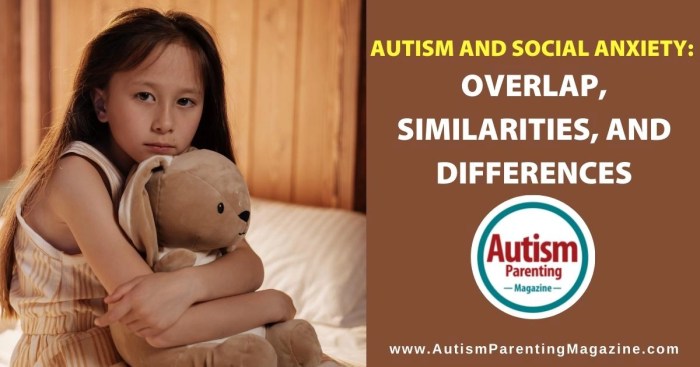
Autism social comparison essay delves into the unique ways individuals on the autism spectrum experience social comparisons. This exploration examines how differences in social skills and communication impact their self-perception and emotional well-being, offering insights into fostering a more inclusive environment for autistic individuals.
The essay will detail the distinctive social comparison processes experienced by people with autism spectrum disorder (ASD). It will compare these processes to typical social comparison patterns, highlighting the potential challenges and differences. This analysis will include discussions on social skills deficits, communication styles, and the impact on emotional well-being, leading to strategies for promoting positive social comparisons and fostering inclusion.
Introduction to Autism and Social Comparison
Autism spectrum disorder (ASD) encompasses a range of neurodevelopmental conditions characterized by varying degrees of challenges in social communication and interaction, as well as restricted and repetitive patterns of behavior, interests, or activities. These presentations manifest in diverse ways, impacting individuals’ abilities to understand and respond to social cues, navigate social situations, and form meaningful relationships. Individuals with ASD may exhibit different strengths and weaknesses, highlighting the wide spectrum of abilities within the disorder.Social comparison is a fundamental human process where individuals evaluate themselves by comparing their attributes, abilities, and experiences to those of others.
This process can be driven by various motivations, such as self-improvement, self-evaluation, and social adaptation. Different forms of social comparison include upward (comparing to someone perceived as superior), downward (comparing to someone perceived as inferior), and lateral (comparing to someone similar). The motivations and outcomes of social comparison can vary significantly depending on the individual’s personal experiences and social context.
Understanding Social Comparison in ASD
Individuals with ASD may experience social comparison differently than neurotypical individuals due to variations in social communication and processing. These differences can lead to unique challenges and potentially distinct outcomes. Understanding these nuances is crucial for fostering supportive environments and interventions.
Comparison of Social Comparison Processes
| Aspect | Typical Social Comparison | Potential Social Comparison in ASD |
|---|---|---|
| Motivation | Self-improvement, self-evaluation | Understanding social norms, seeking inclusion |
| Strategies | Direct observation, indirect feedback | Limited social cues, reliance on concrete information |
| Outcome | Positive self-perception, improved performance | Potential for social isolation, anxiety |
The table above illustrates potential differences in social comparison processes between neurotypical individuals and those with ASD. While typical social comparison often aims for self-improvement, individuals with ASD may primarily seek to understand social norms and find ways to be included in social activities. Typical social comparison strategies often rely on observing others and gathering feedback, whereas individuals with ASD may find these strategies less effective or readily accessible, instead focusing on tangible and concrete information.
This difference can potentially lead to outcomes such as social isolation or anxiety, as the individual may struggle to accurately gauge social situations and their place within them. Further research is needed to understand the complexities and nuances of social comparison within the autism spectrum.
Social Skills and Communication in ASD

Navigating the social world can be incredibly challenging for individuals with Autism Spectrum Disorder (ASD). Communication and social skills are often at the heart of these difficulties. Understanding the nuances of these challenges is crucial for fostering inclusive environments and supporting individuals with ASD in developing their full potential.Social skills deficits in individuals with ASD are diverse and multifaceted.
Thinking about autism social comparison essays can be tough, especially when you’re trying to figure out different perspectives. It’s fascinating to see how experiences like those explored in the “Stephanie Land maid hire housecleaner essay” stephanie land maid hire housecleaner essay might influence our understanding of social dynamics and societal pressures, which in turn helps shape the way we view the broader topic of social comparison within the autism spectrum.
Ultimately, these types of essays can offer valuable insights into how individuals navigate social situations.
They can manifest in a wide range of behaviors, impacting interactions, relationships, and overall well-being. These deficits are not merely about avoiding social interaction; they stem from difficulties in understanding and responding to social cues, which can significantly affect social comparison processes.
Social Skills Deficits in ASD, Autism social comparison essay
Individuals with ASD may exhibit difficulties with various social skills, including understanding nonverbal cues, initiating and maintaining conversations, recognizing social hierarchies, and expressing emotions appropriately. These deficits can hinder the ability to accurately gauge how others perceive them and how they compare to others in social contexts. For instance, someone with ASD might misinterpret a friendly gesture as a sign of disapproval, leading to social isolation and a skewed perception of social comparison.
This can impact self-esteem and overall well-being.
Communication Styles in ASD
Communication in ASD is as varied as the individuals themselves. Some individuals might struggle with verbal fluency, while others might exhibit repetitive or unusual speech patterns. Nonverbal communication can also be challenging, with individuals potentially misinterpreting body language or facial expressions, affecting their understanding of social dynamics and their place within them. Written communication might be affected by organization or social appropriateness concerns, making online interactions or written social comparison potentially difficult.
Impact of Communication Modalities on Social Comparison
| Communication Modality | Typical Use | Potential Use in ASD | Impact on Social Comparison |
|---|---|---|---|
| Verbal | Expressing thoughts, feelings, needs | May struggle with fluency, pragmatics, and turn-taking in conversations. | Difficulty understanding nuanced social cues, like sarcasm or implied meaning, leading to misinterpretations and potentially distorted social comparisons. |
| Nonverbal | Expressing emotions, understanding social cues | May misinterpret body language, facial expressions, and tone of voice, leading to difficulties in understanding social context and emotional states of others. | Difficulty accurately gauging others’ emotions and intentions, potentially affecting perceptions of social comparison and self-perception. |
| Written | Sharing information, engaging in dialogue | May struggle with organization, social appropriateness in written communication, and understanding implied meanings in written texts. | Difficulty in online or written social comparison, as nuances of tone and context can be missed, potentially leading to misinterpretations of others’ perspectives. |
Impact of Social Comparison on Emotional Well-being

Social comparison, the process of evaluating oneself in relation to others, is a fundamental aspect of human social interaction. However, for individuals with autism spectrum disorder (ASD), this process can have a significantly different and potentially more challenging impact on their emotional well-being. The experience of social comparison can vary widely depending on individual differences within the spectrum, and understanding these nuances is crucial for supporting those with ASD.The impact of social comparison on emotional well-being in individuals with ASD is multifaceted and often complex.
It’s not simply a matter of feeling inferior or superior; rather, the way social cues are interpreted and processed can significantly affect self-perception, confidence, and overall mental health. This intricate interplay can lead to a range of emotional responses, highlighting the importance of tailored support strategies.
My latest essay on autism social comparison delves into the fascinating complexities of how individuals with autism perceive social situations. It’s a fascinating look at the nuances of social interaction and how these perceptions can be shaped by various factors. Interestingly, the escalating severity of big winter storms, like those frequently linked to climate change climate change big winter storms , might also offer parallels to the challenges faced in navigating social interactions.
Ultimately, my essay aims to shed light on the unique perspectives of autistic individuals and how we can better understand them.
Emotional Consequences of Social Comparison in ASD
Social comparison can trigger a wide spectrum of emotional responses in individuals with ASD. These reactions are often rooted in the unique way individuals with ASD perceive and process social information, leading to different outcomes than those typically observed in neurotypical individuals. For example, some may experience heightened anxiety when observing social interactions that they perceive as different from their own experiences.
Others may struggle to identify and interpret subtle social cues, leading to feelings of inadequacy or misunderstanding.
Influence on Self-Esteem and Confidence
Social comparison can significantly influence self-esteem and confidence in individuals with ASD. If an individual with ASD consistently perceives themselves as falling short in social situations compared to others, this can negatively impact their self-worth and confidence. Conversely, positive social comparisons can lead to feelings of accomplishment and validation. The key is understanding the specific lens through which an individual with ASD is viewing these comparisons.
Different Emotional Responses to Social Comparison
Individuals with ASD may express social comparison differently. Some might exhibit overt anxiety or withdrawal, while others might manifest their discomfort through challenging behaviors or emotional outbursts. Understanding the specific communication styles and coping mechanisms of individuals with ASD is crucial for accurate interpretation of their emotional responses. For instance, a child with ASD might become withdrawn and quiet in social situations, whereas an adolescent might exhibit repetitive behaviors or vocalizations.
Social Comparison and Social Anxiety/Isolation
Social comparison can contribute significantly to social anxiety and isolation in individuals with ASD. The fear of not measuring up to perceived social norms, or the struggle to understand and respond appropriately to social cues, can lead to avoidance behaviors. This can result in a vicious cycle of limited social interaction, exacerbating feelings of isolation and anxiety. For example, a young adult with ASD might avoid social gatherings because of anxiety about not knowing how to participate or interact appropriately.
Strategies for Managing Emotional Responses
Developing strategies to manage these emotional responses is crucial for promoting emotional well-being and social inclusion. Understanding the individual’s unique social communication style, strengths, and challenges is vital. Supporting the development of coping mechanisms, such as mindfulness techniques, social skills training, and cognitive behavioral therapy (CBT), can equip individuals with ASD to navigate social comparison more effectively. Providing positive reinforcement and opportunities for successful social interactions can significantly bolster self-esteem and confidence.
My latest essay draft on autism social comparison is really focusing on how different social experiences shape individual development. It’s fascinating how societal pressures, like the recent trend of women refusing to participate in the Trump economy, women refusing to participate in trump economy , can subtly influence a person’s sense of self. Ultimately, I’m hoping to highlight the importance of recognizing these diverse experiences in the context of autism research.
For example, a structured social skills group can help individuals with ASD develop strategies for managing social anxiety and interacting with others more comfortably.
Social Comparison and Social Inclusion
Social comparison is a fundamental aspect of human interaction, influencing our self-perception and motivation. For individuals with autism spectrum disorder (ASD), this process can be particularly complex, affecting their social inclusion and overall well-being. Understanding the unique challenges and opportunities within social comparison can be crucial in creating more supportive and inclusive environments for those with ASD. It’s not about changing who someone is, but rather understanding their unique perspective and adapting the environment to support their needs.Navigating social situations often requires interpreting subtle social cues and adjusting communication styles to connect with others.
Individuals with ASD may struggle with these nuances, potentially leading to misinterpretations and difficulties in forming meaningful connections. This essay explores how understanding social comparison within ASD can pave the way for more inclusive social environments, emphasizing strategies that address specific needs.
Strategies for Social Inclusion Considering Unique Needs
Social inclusion strategies must acknowledge the diverse needs of individuals with ASD. General approaches that work for neurotypical individuals may not be effective for those with ASD. Instead, a nuanced understanding of their specific challenges and strengths is crucial.
- Structured Social Environments:
- Clear Communication Strategies:
- Promoting Peer Support and Role Models:
Creating structured social environments can significantly reduce anxiety and improve social participation. Structured activities with clear expectations, visual supports, and opportunities for repetition can provide a safe and predictable social space. For example, a structured group activity, like a board game with clear rules and visual aids, can help participants feel more comfortable and confident interacting. The structured format provides clear expectations and reduces ambiguity, allowing individuals with ASD to better understand social interactions.
Communicating effectively is vital for social interaction. Explicit and clear communication strategies, including visual aids, social stories, and simplified language, can facilitate understanding and reduce misunderstandings. For example, a social story outlining expected behaviors in a particular social situation can empower an individual with ASD to better navigate that context. This direct approach provides clarity and minimizes the potential for misinterpretation.
Exposure to positive role models and peer support groups can be powerful tools for social inclusion. When individuals with ASD see others successfully navigating social situations, it can build confidence and reduce feelings of isolation. Creating a support group of peers or neurotypical individuals who understand ASD can also foster a sense of belonging and shared experiences. Examples include peer mentorship programs or social groups tailored to the specific needs of individuals with ASD.
Positive Social Interactions and a Sense of Belonging
Positive social interactions are essential for fostering a sense of belonging. These interactions should be tailored to the individual’s specific needs, preferences, and communication styles.
- Shared Interests and Activities:
- Visual Supports and Nonverbal Communication Training:
Focusing on shared interests and activities can create natural opportunities for interaction and connection. Activities like participating in a sports club, joining a book club, or attending workshops related to specific interests can facilitate meaningful social interactions. The shared experience of engaging in something they enjoy can build rapport and establish a sense of shared identity.
Understanding nonverbal communication is crucial. Using visual supports, such as social stories or visual schedules, can enhance comprehension and reduce ambiguity. Combining visual supports with specific training on nonverbal cues can improve the ability to interpret and respond appropriately. For example, a visual chart illustrating different facial expressions and their corresponding emotions can aid understanding. Training in appropriate nonverbal communication, like eye contact, can significantly enhance social interactions.
Potential Barriers to Social Inclusion
| Barrier | Explanation | Mitigation Strategies |
|---|---|---|
| Difficulty interpreting social cues | Misunderstanding nonverbal communication | Structured social skills training, visual supports, and role-playing activities |
| Differing communication styles | Communication gaps | Clear communication strategies, using visual aids, and actively listening |
| Sensitivity to social pressure | Increased anxiety | Creating a supportive social environment, providing choices, and reducing pressure |
Strategies for Promoting Positive Social Comparison
Navigating social comparisons can be a significant challenge for individuals with autism spectrum disorder (ASD). While social comparison itself is a natural human process, the way individuals with ASD perceive and respond to these comparisons can differ. Understanding the nuances of social comparison in ASD is crucial for developing effective strategies to foster positive self-perception and social inclusion.
Positive social comparison, in this context, refers to using social comparisons to identify strengths and areas for growth, promoting self-acceptance, and fostering a sense of belonging.Promoting positive social comparison experiences involves a multifaceted approach that goes beyond simply highlighting achievements. It requires creating a supportive environment that encourages healthy self-perception and acceptance. This environment must acknowledge the unique strengths and challenges of individuals with ASD, facilitating meaningful interactions and building self-esteem.
Strategies for Fostering Healthy Self-Perception
A critical aspect of promoting positive social comparison is establishing a strong foundation of self-acceptance. Individuals with ASD often experience unique challenges in self-perception, potentially leading to feelings of inadequacy or isolation. Therefore, strategies should focus on building self-esteem, encouraging self-advocacy, and celebrating individual strengths.
- Identifying and Celebrating Strengths: Focusing on individual strengths and accomplishments, rather than solely on deficits, is paramount. This involves actively recognizing and praising unique skills, talents, and interests. For example, a child with ASD who excels in math might be praised for their problem-solving abilities, while a child with exceptional artistic talent might be encouraged to pursue their creative expression.
- Encouraging Self-Advocacy: Teaching individuals with ASD how to articulate their needs and preferences in social situations is crucial. This can be achieved through role-playing, communication training, and providing opportunities for them to express their thoughts and feelings in a safe environment. This empowers them to take control of their social interactions and feel more confident in navigating social comparisons.
- Promoting Self-Acceptance: Creating a supportive environment that embraces differences and acknowledges that all individuals have strengths and weaknesses is vital. This includes emphasizing that comparison to others isn’t the measure of self-worth and that individuals with ASD are valuable members of society regardless of their social skills.
Evidence-Based Practices for Positive Social Comparison
Utilizing evidence-based practices can significantly impact the effectiveness of strategies for promoting positive social comparison. These practices are designed to create a supportive environment and foster a sense of belonging.
- Social Skills Training: Structured social skills training programs can equip individuals with ASD with the tools and strategies needed to navigate social situations more effectively. These programs can help them develop appropriate communication skills, understand social cues, and manage challenging interactions, thereby reducing anxiety associated with social comparison.
- Positive Reinforcement: Positive reinforcement plays a key role in building self-esteem and encouraging desired behaviors. Recognizing and rewarding prosocial behaviors, even small ones, can significantly impact a child’s self-perception and motivation to engage in social interactions. This can include praise, tokens, or other positive feedback.
- Sensory Integration Therapy: Sensory sensitivities are common in individuals with ASD. Sensory integration therapy can help manage these sensitivities, which can impact social interactions and perceptions of self. By reducing sensory overload, individuals can be more comfortable in social settings, allowing for more positive interactions and comparisons.
Facilitating Meaningful Interactions
Meaningful interactions are fundamental to fostering a sense of belonging and encouraging positive social comparison. These interactions need to be tailored to the individual’s needs and preferences, focusing on shared interests and activities.
- Identifying Shared Interests: Understanding the individual’s unique interests can guide the creation of opportunities for interaction. Finding activities that cater to these interests can lead to more natural and meaningful connections, enabling positive social comparisons based on shared experiences rather than just perceived social skills.
- Creating Inclusive Environments: Promoting inclusive environments that value diversity and differences is crucial. This includes creating opportunities for social interaction that are structured and supportive, ensuring that all individuals feel welcome and accepted. For example, a school or community group can be structured to cater to different learning styles and social needs.
- Supporting Peer Relationships: Supporting peer relationships is important to promote positive interactions. This involves fostering a sense of community where individuals with ASD feel valued and included. This can include peer mentoring programs or activities designed to build positive relationships.
Parental and Educational Support
Parents and educators play a vital role in supporting children with ASD in navigating social comparisons. Their understanding and support can significantly impact a child’s self-perception and overall well-being.
- Modeling Positive Social Behaviors: Parents and educators can model appropriate social interactions and communication styles. Demonstrating empathy, active listening, and respectful communication can set a positive example for children with ASD.
- Providing Clear Expectations: Clear and consistent expectations for social interactions can help children with ASD understand social norms and boundaries. This can reduce anxiety and promote more positive experiences in social situations.
- Collaboration with Professionals: Collaboration with professionals, such as therapists and educators, is essential for developing personalized strategies tailored to the child’s specific needs. This collaborative approach ensures that the strategies employed effectively address the individual’s challenges and strengths.
Last Recap: Autism Social Comparison Essay
In conclusion, autism social comparison essay underscores the importance of understanding the unique experiences of individuals with autism. By recognizing the differences in social comparison processes, we can better support their emotional well-being and foster more inclusive social environments. Strategies for promoting positive social interactions and building a sense of belonging are crucial to creating a supportive community for autistic individuals.


